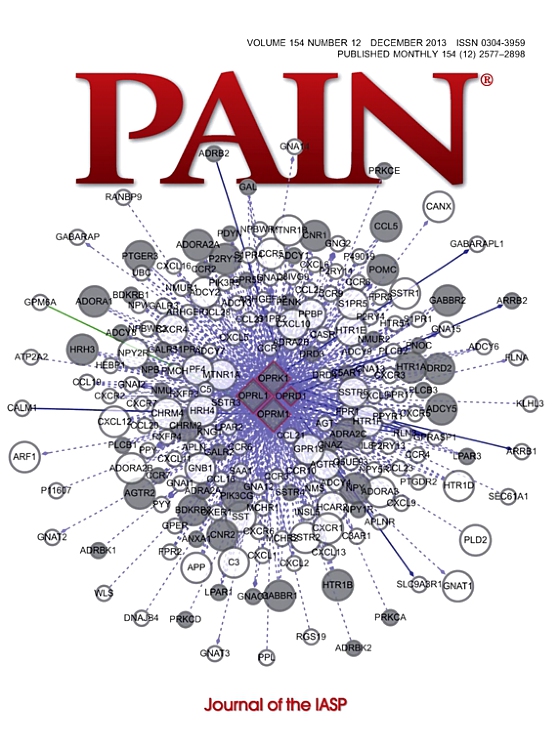Deficits in temporal pain inhibition are associated with greater pain and functional impairment in osteoarthritis.
IF 5.9
1区 医学
Q1 ANESTHESIOLOGY
引用次数: 0
Abstract
Offset analgesia reflects time-dependent, central nervous system pain inhibition and refers to a dramatic drop in pain intensity after an offset of noxious stimulus intensity. Neuropathic and nociplastic pain conditions with strong central nervous system pathophysiologic mechanisms show deficits in offset analgesia. Whether offset analgesia is altered in more peripherally driven chronic nociceptive pain was unknown. Therefore, the primary goal of the current study was to determine whether chronic nociceptive pain is associated with changes in offset analgesia. We measured offset analgesia and sensory function using quantitative sensory tests, patient-reported pain and function, and walking and stair climbing performance using standardized tasks in knee osteoarthritis patients with equivalent joint degeneration but Moderate-to-Severe (n = 36) or Mild pain intensity (n = 36) and Pain-free controls without knee osteoarthritis (n = 30) matching for age, gender, and body mass index. Offset analgesia was significantly reduced in knee osteoarthritis groups compared with the Pain-free controls, with deficits occurring at both the nonpainful forearm and painful knee and in both genders. Greater deficits in offset analgesia were associated with more impairment in walking and stair climbing. Onset hyperalgesia, a novel measure of time-dependent pain facilitation, was reduced in women with Mild knee pain but not in men. These results suggest that deficits in temporal pain inhibition and gender-specific changes in temporal pain facilitation may contribute to pain and functional impairment in knee osteoarthritis, supporting further study of central pain modulation as a clinically relevant mechanism of chronic nociceptive pain.在骨关节炎中,颞痛抑制的缺陷与更大的疼痛和功能损害有关。
补偿镇痛反映了时间依赖性,中枢神经系统疼痛抑制,是指在有害刺激强度补偿后疼痛强度的急剧下降。中枢神经系统病理生理机制较强的神经性和致癌性疼痛表现出补偿性镇痛的缺陷。在外周驱动的慢性伤害性疼痛中,偏移性镇痛是否发生改变尚不清楚。因此,本研究的主要目的是确定慢性伤害性疼痛是否与补偿性镇痛的改变有关。我们通过定量感觉测试、患者报告的疼痛和功能,以及采用标准化任务测量具有同等关节退变但中度至重度(n = 36)或轻度疼痛强度(n = 36)的膝关节骨性关节炎患者的步行和爬楼梯表现,以及与年龄、性别和体重指数相匹配的无疼痛对照(n = 30)无膝关节骨性关节炎患者。与无疼痛对照组相比,膝关节骨关节炎组的偏移性镇痛明显减少,在无疼痛的前臂和疼痛的膝关节以及男女中都出现了缺失。偏移性镇痛的更大缺陷与行走和爬楼梯的更多损害相关。发作痛觉过敏,一种新的测量时间依赖性疼痛促进,在轻度膝关节疼痛的女性中减少,但在男性中没有。这些结果表明,颞痛抑制缺陷和颞痛促进的性别特异性变化可能导致膝关节骨关节炎的疼痛和功能损害,支持进一步研究中枢性疼痛调节作为慢性伤害性疼痛的临床相关机制。
本文章由计算机程序翻译,如有差异,请以英文原文为准。
求助全文
约1分钟内获得全文
求助全文
来源期刊

PAIN®
医学-临床神经学
CiteScore
12.50
自引率
8.10%
发文量
242
审稿时长
9 months
期刊介绍:
PAIN® is the official publication of the International Association for the Study of Pain and publishes original research on the nature,mechanisms and treatment of pain.PAIN® provides a forum for the dissemination of research in the basic and clinical sciences of multidisciplinary interest.
 求助内容:
求助内容: 应助结果提醒方式:
应助结果提醒方式:


